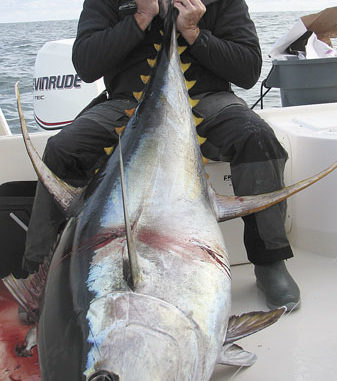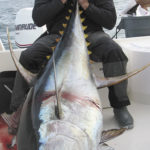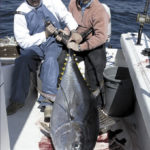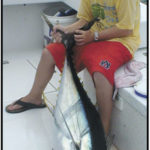
As massive schools of mullet migrate just offshore to spawn, hungry tuna move in to make their lives miserable.
The one thing that has kept me standing at the dock more often than not when it comes to catching tuna is that they are offshore. Although I’ve been told not to let my bad trips turn me off, I can’t go offshore for the same reason I can’t eat tomato gravy even though I love tomato gravy. Although I love the taste, the smell of it cooking on momma’s stove is all it takes to evoke bad memories of regurgitated tomato gravy spewing from my mouth and nose one day after eating it while I had a stomach bug in elementary school.
For the same reason, I find it very difficult to go offshore. I love catching and eating tuna, but I just can’t repress the memory of turbulent trips that gave me white knuckles and buckled knees. And just thinking about the combination of a boat being tossed by rolling waves for the duration of a two-hour trip makes me toss my cookies before I even meet the crew.
All I can say is thank God for October and thank God for big fat roe-laden mullet that are genetically disposed to become tuna bait this time of year. Every autumn, mullet move offshore to lay their eggs as early as September and as late as November but usually sometime in October.
“In order for the roe to stay afloat, the mullet have to move into water with a higher salinity level,” said Capt. Damon McKnight with Strike Zone Charters (800-318-1720). “The saltier the water is the more buoyant it is, and the tuna have probably been taking advantage of those fat roe-filled mullet for as long as tuna and mullet have been around.”
McKnight recalled that last October was one of the best months of tuna fishing in his memory. The yellowfin action was incredible, and his boat brought in lots of big fish.
“It was just one of those months that the tuna moved in close, and the tuna anglers were there to take advantage of it,” he said. “Compared to other months, October can vary from year to year. But when it’s right, October can be one of the better months mainly due to size and the number of fish caught.”
And it is the “moved in close” part of McKnight’s assessment that makes pansy-ass anglers like me happy to know that some of the best tuna fishing of the year takes place as close as five miles out of the mouth of the Mississippi River.
Although five miles is what gets tossed around in casual conservation, McKnight says the closest he’s seen them and caught them was about seven miles offshore during October. Even still, it’s hard to argue with a seven-mile ride out of the mouth of the river to get to giant yellowfin tuna.
“Most of the time, you won’t find them during October as shallow as you’ll find them during the winter moths,” McKnight said. “During the winter, they’ll come in as shallow as 195 feet; during October, they’re usually in 300 feet or better. But it wouldn’t surprise me to see them come in shallower than that during October as long as the conditions allow.”
And the main condition that drives how shallow tuna will go is the location of the mullet. McKnight says it wouldn’t surprise him if tuna came in even closer than what most people think they would. They follow the food, and as long as the water conditions and temperature are good enough for them to survive, tuna will go anywhere and as shallow as they want.
Although he hasn’t been chasing tuna during the mullet spawn as long as McKnight has, Erik Newman with Team Blue Runner Foods has been at it long enough to know just how close the tuna get this time of year. And he’s had days during which he has caught giant tuna in what many would consider bad water.
“You got the whole thing about the blue water,” Newman said, “but we’ve caught tuna in some really dirty green water during October — almost river water during the mullet run. If the mullet are in that kind of water, the tuna will be in it too. My experience is that they’ll come into that dirty water to eat.”
Although it’s been said that mullet can become “tuna crack” this time of year, McKnight and Newman say the tuna’s preference for this particular baitfish has more to do with them seeking out what Mother Nature offers them to eat rather than them seeking out a treat so delectable that they just have to have it.
“In my opinion, tuna will eat what nature provides,” said McKnight. “Let’s say it’s the middle of July, and you set out a mullet on one line and a hardtail on the other. More than likely, the hardtail will get eaten first (that time of year). But during October and November, they will eat both.”
McKnight went on to say that when hardtails become very scarce during the hard winter months, tuna become more in tune with the mullet. And since tuna are frequently hard to understand, he always takes both baits with him on every trip.
Newman knows just how finicky tuna can be, too, and he’s heard of people trying hardtails without much success when the tuna are so frenzied about eating mullet.
“When tuna are feeding on something, that’s what they want to eat,” Newman said. “Take for example when they’re eating threadfin herring. You can throw a hardtail and hit him in the face, but he’s not going to eat it. With so many mullet out there, and that being what tuna are eating, I’ve only caught them on mullet and chunks this time of year.”
Finding the large mullet schools can be pretty easy on some days, and McKnight says if there is a large school of them offshore and the tuna are busting on them, you will definitely have no trouble seeing the school.
Newman equated the scene to how mullet jump out of the water when schools of jack-fish are slashing into them from underneath. If nothing is bothering them, they look like typical schools of mullet swimming with their heads above the surface. But when the tuna get hungry, it’s more like a scene from a horror movie.
“A lot of times the tuna will be pushing them up from the bottom of the school, and you’ll see them all scatter and jump out of the water,” said Newman. “At other times, though, the tuna will actually be blowing up through the middle of the schools and going airborne, and that’s totally wicked when they do that.”
Fishing the mullet schools sounds a lot like sitting on the side of the road tightlining a shiner with a cane pole, and Newman says he typically positions his boat on the side of the schools and hooks on a live mullet before peeling off 20 to 50 yards of line.
“It doesn’t take much,” he said. “After pulling off the line, I put my rods in the riggers and bump-troll around the school. Bump-trolling is when we may have one engine running, and we bump it in and out of gear to move just enough to keep tension on our lines. We don’t want any slack in it when we get a bite, and we definitely don’t want a hooked fish getting in the engines.”
McKnight pointed out that the only thing you can really do to get the bait is to get the mullet while you’re out on the water, and he added that he believes it’s important to set up on top of the crashing fish and not so much the mullet school itself.
“You may run across several different mullet schools and never see a single tuna,” he said. “Some days you might not even see a single mullet. In this case, we just fish tuna in the areas that they usually frequent during the fall.
“Sometimes we catch, and sometimes we don’t. But we know they’re feeding on mullet even if we don’t see it happening because they’re full of them, which we find out later back at the dock when we clean our fish.”
All this awesome tuna action so close to the mouth of the Mississippi River is enough to turn the weakest among us into seafaring soldiers willing to take on a 2-foot chop without having to depend on Dramamine.
Now if I could just hold down Momma’s tomato gravy.


